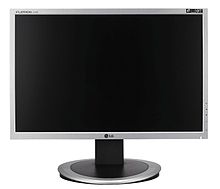This is an old revision of this page, as edited by Urklistre (talk | contribs) at 10:27, 5 August 2012 (→Industry moves away from 16:10 in 2008 to 16:9). The present address (URL) is a permanent link to this revision, which may differ significantly from the current revision.
Revision as of 10:27, 5 August 2012 by Urklistre (talk | contribs) (→Industry moves away from 16:10 in 2008 to 16:9)(diff) ← Previous revision | Latest revision (diff) | Newer revision → (diff)
16:10, also known as 8:5, is an aspect ratio mostly used for computer displays. The width of the display is 1.6 times its height.
LCD computer displays using the 16:10 ratio started to appear in the mass market from 2003. By 2008 16:10 had become the most common aspect ratio for LCD monitors and laptop displays. Since 2010, however, 16:9 has the become the mainstream standard, driven by the 1080p standard for high definition television.
History
Computer Displays
Industry moves towards 16:10 from 2003 to 2008
Until about 2003, most computer monitors had a 4:3 aspect ratio and some had 5:4. Between 2003 and 2006, monitors with 16:10 (8:5) aspect ratios became commonly available, first in laptops and later also in standalone monitors. Reasons for this transition were productive uses for such monitors, i.e. besides widescreen movie viewing and computer game play, are the word processor display of two standard letter pages side by side, as well as CAD displays of large-size drawings and CAD application menus at the same time.
In 2005-2008, 16:10 took over the position from 4:3 as the most sold aspect ratio for LCD monitors. At the time, 16:10 also had 90 percent of the notebook market and was the most common used aspect ratio for laptops. However, 16:10 had a short reign as the most common aspect ratio.
Industry moves away from 16:10 in 2008 to 16:9
Around 2008-2010, there was a rapid shift by computer display manufacturers to the 16:9 aspect ratio, and by 2011, 16:10 had almost disappeared from new mass market products.
The primary reason for this move is considered to be production efficiency - since display panels for TVs use the 16:9 aspect ratio, it's more efficient for display manufacturers to produce computer display panels in the same aspect ratio as well. A 2008 report by DisplaySearch also cited a number of other reasons:
- Innovative product concepts drives a new product cycle and stimulating the growth of the notebook PC and LCD monitor market.
- 16:9 provides better economic cut (panelization) in existing TFT LCD fabs.
- 16:9 products provide higher resolution and wider aspect ratio.
- The widespread adoption of High Definition in the consumer entertainment sector will help end users readily adopt the new products with the wider aspect ratio.
- The 16:9 panels provide an opportunity for PC brands to further diversify their products.
The shift from 16:10 to 16:9 has been met with a mixed response. The lower cost of 16:9 computer displays, along with the convenience of having the same aspect ratio in different devices, has been seen as a positive. There has been discussion though whether 16:9 or the more squarish format 16:10 is most suitable aspect ratio for computer displays. Some people prefer the wider 16:9 aspect ratio better while others prefer the higher 16:10 and use the golden ratio as an argument. Also some believe productivity-oriented tasks to benefit more from vertical resolution rather than horizontal and thus consider 16:10 displays to be more suitable for such tasks for that reason. However actual studies have shown that there actually are productivity gains with a wider aspect ratio.
Tablets
Tablets became a popular during the late 00s. The first tablets were in 4:3 but 16:10 tablets became soon popular.
Mobile Phones
In late 00s 16:10 became very popular in mobile phones. During 2012 there has been a shift to 16:9, however, Apple still produces their mobile phones in 16:10.
Common screen resolutions of 16:10 screens
| Name | Dimensions | Diagonal screen size |
|---|---|---|
| WXGA | 1280×800 | 13–15 in (33–38 cm) |
| WXGA+ | 1440×900 | 13–19 in (33–48 cm) |
| WSXGA+ | 1680×1050 | 15–22 in (38–56 cm) |
| WUXGA | 1920×1200 | 17–28 in (43–71 cm) |
| WQXGA | 2560×1600 | 30 in (76 cm) |
See also
- Display aspect ratio - Different aspect ratios for computer monitors.
- Aspect ratio (image)
- Computer display standard
References
- Knight, Dan (2008-09-19). "With 10% of the US Notebook Market, Where Will Apple Go Next?".
- ^ "Product Planners and Marketers Must Act Before 16:9 Panels Replace Mainstream 16:10 Notebook PC and Monitor LCD Panels, New DisplaySearch Topical Report Advises". DisplaySearch. 2008-07-01. Retrieved 2011-09-08.
- ^ Ricker, Thomas (2008-07-02). "Widescreen LCDs going widescreen by 2010". Engadget.
- NEMATech Computer Display Standards http://www.millertech.com/Technical_Specs.htm
- "Introduction--Monitor Technology Guide". necdisplay.com. Archived from the original on 2007-03-15. (currently offline)
- Miller, Michael J. (2008-03-21). "Where Displays Are Heading". PC Magazine. Retrieved 2012-07-09.
- Kowaliski, Cyril (2008-07-02). "DisplaySearch: Transition to 16:9 displays is 'unstoppable'". The Tech Report. Retrieved 2012-07-09.
- "Product Planners and Marketers Must Act Before 16:9 Panels Replace Mainstream 16:10 Notebook PC and Monitor LCD Panels, New DisplaySearch Topical Report Advises". DisplaySearch. 2008-07-01. Retrieved 2011-09-08.
- "Gateway's 16:10 displays show common sense". The Inquirer. 2010-07-16. Retrieved 2012-07-09.
- Ulanoff, Lance (2008-08-27). "Stop Shrinking My Laptop Screen". PC Magazine. Retrieved 2012-07-09.
- Novakovic, Nebojsa (2011-08-26). "Monitor Aspect Ratios - Beyond 16:9, iPad to the rescue?". VR-Zone. Retrieved 2012-07-09.
- http://productivepractices.com/content/monitors_and_productivity.php